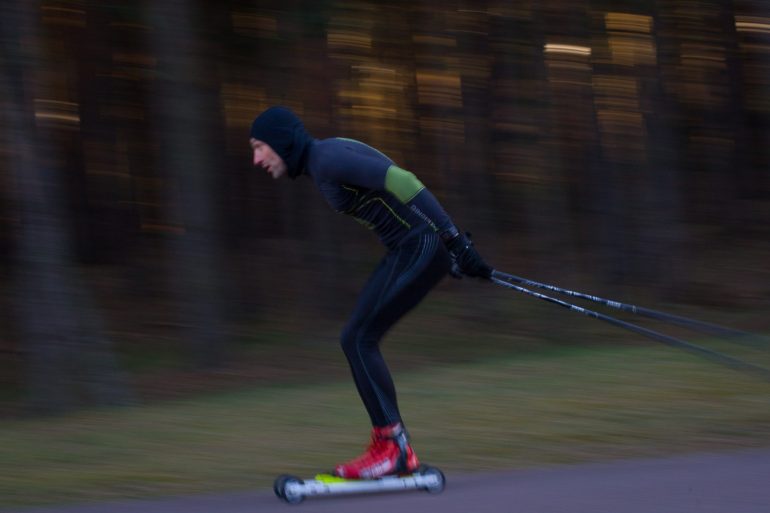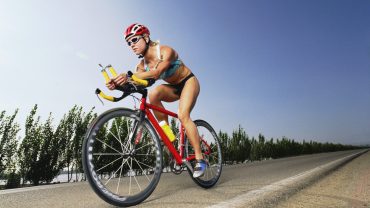Roller skiing was originally intended as a training activity for cross-country skiers in the summer months when there was no snow. Today, it is one of the fastest-growing extreme sports.
Not only is it an exciting, high-octane sport, it’s lots of fun and a fantastic way to stay in shape for those who don’t like the gym and want something more interesting than jogging!
Roll up for the lowdown on roller skiing and we’ll explain exactly what are roller skis!
A Short History of Roller Skiing

Rollerskiers roadside (Photo: Nathan Bilow via Getty Images)
What is roller skiing? Well it isn’t anything new. In fact the Italians and northern Europeans have been attaching wheels to skis since the 1920s. Yet it wasn’t until the 1950s – when the sport of cross-country skiing was gaining in popularity and competitiveness – that athletes realised they needed to train all year round.
Fast-forward to the 1970s and the first mass-produced roller skis – not much more than basic metal frames between 70cm and one metre long – were made with three wheels, one up front and two at the back. They were heavy and hard to handle but today, for rollerski sport they are lighter, more flexible and much easier to control.
In 1976, an Italian pilot by the name of Giustino del Vecchio designed a pair of roller skis from aircraft materials. The wheels were narrow and solid and they had reverse lock-up ball bearings so skiers could push off from a standing start. To test them he skied a remarkable 240.5km in 24 hours.
The first official rollerskiing championships took place in 1988 in the Netherlands, and the Federation Internationale du Ski (FIS) recognised rollerski sport completely distinct from its cold cross-country cousin.
The Two Types of Roller Skiing

Close up of rollerskis (Photo: Idaho Statesman via getty Images)
The answer to the question ‘what are roller skis’ can be split into two parts – skate and classic.
Classic roller skiing almost exactly mirrors cross-country skiing. The skis run parallel and the wheels have ratchets which stop them rolling backwards. They are slightly longer than skate skis and have wide, soft rubber wheels. One of the wheels has a one-way needle-bearing which ensures the skier can ‘kick’, emulating the classic snow striding technique.
Skate-style roller skis are very similar to ice skates and inline skates, whereby the skier moves in a left to right style. The wheels – made from polyurethane or a hard rubber compound – are much narrower and firmer and there are no ratchets. The skate style is used predominantly by biathlon athletes and people who take up roller skiing for fun and exercise.
A widely held view is that classic rollerskiing is easier to learn but harder to master while skating is harder to learn as a beginner but easier to get proficient at.
Roller Skiing Equipment - What Do You Need?

Rollerskiing gear (Photo: NurPhoto via Getty Images)
First off, you need a pair of roller skis for the discipline you opt for – classic style or skate style – and similar to all types of sporting equipment such as tennis rackets, prices can differ quite dramatically from the less expensive end of the market to the top of the range.
Cross-country skiers and biathletes use the same boots and bindings from their snow skis, and it’s advisable to wear thick socks so you get a perfect fit for your boots which need to be snug but not too tight.
The poles differ slightly. Snow poles have rubber tips and ‘baskets’ on the bottom so they don’t sink too far into the powder but poles for roller skiing are slightly different. The material is the same but the tips (also called ferrules) need to be extremely hard-wearing for constant contact with tarmac or hard paths, so most are made from a durable metal called tungsten, the same material from which darts are made.
In terms of the other roller skiing equipment required, it’s similar to skateboarding or inline skating. Clothing shouldn’t be too baggy and the standard protective equipment including gloves, a helmet, knee and elbow pads, wrist protectors and protective eyewear should all be worn.
Rollerski - Sport, And So Much More

Rollerskiing practice (Photo: Portland Press Herald via Getty Images)
When you ask ‘what is roller skiing’, the first and most obvious answer is that it’s an awesome extreme sport but it’s so much more.
Roller skiing uses almost every muscle in the body (including some you never knew you had!), it’s a superb cardiovascular workout with minimal impact, it can be done almost anywhere, it builds strength, coordination and improves balance and it’s lots of fun!
So now you know the answer to the question ‘what are roller skis’ and the roller skiing equipment you need, it might be time to get out there and give it a go!











